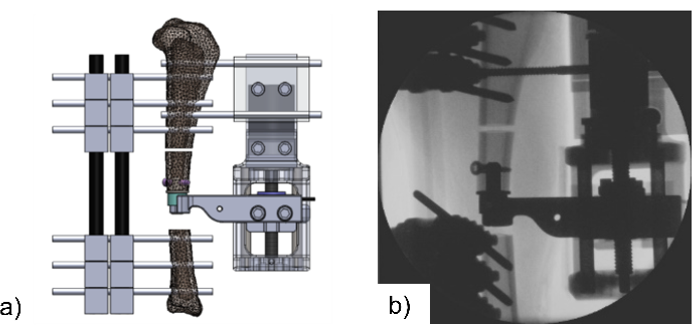Background
Despite decades of research on mechanobiology of fracture repair, certain aspects in the field remain untouched. Especially the impact of temporal variation of mechanical stimulus is only barely understood. However, there might be huge potential in the field to improve speed and robustness of healing. Recent preclinical experiments (ImpCon2 Project) suggest that fracture stimulation in an early post-operative phase could be of high importance for robust and timely healing. This important matter should be further investigated.
Goal
A recently introduced experimental two-defect preclinical fracture model (QUT, Brisbane, Australia), implementing an actuator-driven external fixator, allows executing arbitrary stimulation protocols to the fracture site completely independent from functional loading. This implant system will be improved and adapted to the needs of this project and applied in vivo comparing immediate to delayed fracture stimulation.
Results
To enable programming and execution of arbitrary stimulation protocols with the fixator, a dedicated controller was developed and implanted along with the QUT system in 10 Swiss White Alpine sheep randomized in two groups (n=5). The device was programmed to execute an immediate post-operation stimulation protocol for the one of the groups and a 3-week delayed stimulation protocol for the other. In this experimental setting, no significant difference was observed between the groups in terms of healing competence, which might be related to a vascular impairment at the fracture site. However, the developed model enabled continuous monitoring of both the healing progression and short-term response of the healing tissue to strain stimuli over hours and days. The results highlight the importance of resting times during fracture healing. The impact of temporal variations in mechanical fracture stimulation (immediate versus delayed) on bone healing will be further investigated.
-
Publications
Barcik J, Ernst M, Schwyn R, Freitag L, Dlaska CE, Drenchev L, Todorov S, Skulev H, Epari DR, Zeiter S, Gueorguiev B. Development of surgical tools and procedures for experimental preclinical surgery using computer simulations and 3D printing. iJOE. 2020;16(9):183-95
Barcik J, Ernst M, Dlaska CE, Drenchev L, Zeiter S, Epari DR, Windolf M. Programable active fixator system for systematic in vivo investigation of bone healing processes. Sensors. 2021;21(1):17. https://doi.org/10.3390/s21010017
Barcik J, Ernst M, Balligand M, Dlaska CE, Drenchev L, Zeiter S, Epari DR, Windolf M. Short-term bone healing response to mechanical stimulation—A case series conducted on sheep. Biomedicines. 2021;9(8):988. https://doi.org/10.3390/biomedicines9080988
Barcik JP. Modulation of fracture mechanical conditions and feedback approach to determine the optimal healing environment. 2021 Bulgarian Academy of Sciences Sofia (L. Drenchev, S. Todorov, B. Gueorguiev) - PhD thesis
-
Presentations
Barcik J, Ernst M, Freitag L, Dlaska C, Drenchev L, Gueorguiev B, Skulev H, Mys K, Epari D, Windolf M. Automated active fixation system to test the influence of different loading regimes on fracture healing. 2019 ESB Vienna, 07.-09.2019 (poster).
Barcik J, Ernst M, Schwyn R, Freitag L, Dlaska C, Drenchev L, Todorov S, Gueorguiev B, Skulev H, Epari D, Windolf M. Development of tailor-made equipment for experimental preclinical surgeries using computer simulations and 3D printing. 2019 ICMCC, Varna, 25.-27.09.2019 (oral).
Barcik J, Ernst M, Balligand M, Dlaska CE, Drenchev L, Todorov S, Gueorguiev B, Skulev H, Zeiter S, Epari D, Windolf M. Continuous monitoring of fracture healing to analyze short-term response of bone repair tissue to mechanical stimulation. 2019 EORS, Maastricht, 02.-04.10.2019 (oral).
Barcik J, Ernst M, Freitag L, Dlaska CE, Drenchev L, Todorov S, Gueorguiev B, Skulev H, Zeiter S, Hofman-Fliri L, Epari D, Windolf M. Automated electromechanical system designed to investigate the effect of local mechanical conditions on fracture healing progression. 2019 EORS, Maastricht, 02.-04.10.2019 (oral).
Barcik J, Ernst M, Freitag L, Dlaska CE, Drenchev L, Todorov S, Skulev H, Zeiter S, Epari D, Windolf M. Automated active fixation system designed to investigate the influence of local mechanical environment on fracture healing. 2019 TERMIS-AP + ABMC7, Brisbane, 14.-17.10.2019 (poster).
Barcik J, Ernst M, Balligand M, Dlaska CE, Drenchev L, Todorov S, Skulev H, Zeiter S, Epari D, Windolf M. Analysis of the short-term response of fracture repair tissue to mechanical stimulation. 2019 TERMIS-AP + ABMC7, Brisbane, 14.-17.10.2019 (poster).
Barcik J, Ernst M, Balligand M, Dlaska CE, Drenchev L, Todorov S, Gueorguiev B, Skulev H, Zeiter S, Epari D, Windolf M. Continuous monitoring of bone healing by measurement of fracture callus stiffness. 2020 GR forscht virtual (poster).
Barcik J, Ernst M, Buchholz T, Constant C, Mys K, Epari D, Zeiter S, Gueorguiev B, Windolf M. The effect of immediate and delayed mechanical stimulation on secondary bone healing. 2023 EORS (oral)
-
Partners
Epari D (Prof), Queensland University of Technology (QUT), Brisbane, Australia
Dlaska CE (MD), Orthopaedic Research Institute of Queensland, Townsville, Australia
Balligand M (Prof), University of Liège, Belgium


